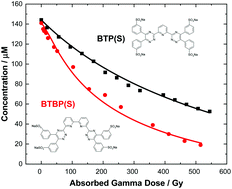Time-resolved and steady-state irradiation of hydrophilic sulfonated bis-triazinyl-(bi)pyridines – modelling radiolytic degradation†
Abstract
Efficient separation of the actinides from the lanthanides is a critical challenge in the development of a more sophisticated spent nuclear fuel recycling process. Based upon the slight differences in f-orbital distribution, a new class of soft nitrogen-donor ligands, the sulfonated bis-triazinyl-(bi)pyridines, has been identified and shown to be successful for this separation under anticipated, large-scale treatment conditions. The radiation robustness of these ligands is key to their implementation; however, current stability studies have yielded conflicting results. Here we report on the radiolytic degradation of the sulfonated 2,6-bis(1,2,4-triazin-3-yl)pyridine (BTP(S)) and 6,6′-bis(1,2,4-triazin-3-yl)-2,2′-bipyridine (BTBP(S)) in aerated, aqueous solutions using a combination of time-resolved pulsed electron techniques to ascertain their reaction kinetics with key aqueous radiolysis products (eaq−, H˙, ˙OH, and ˙NO3), and steady state gamma radiolysis in conjunction with liquid chromatography for identification and quantification of both ligands as a function of absorbed dose. These data were used to construct a predictive deterministic model to provide critical insight into the fundamental radiolysis mechanisms responsible for the ligands’ radiolytic stability. The first-order decays of BTP(S) and BTBP(S) are predominantly driven by oxidative processes (˙OH and, to a lesser extent, H2O2), for which calculations demonstrate that the rate of degradation is inhibited by the formation of ligand degradation products that undergo secondary reactions with the primary products of water radiolysis. Overall, BTP(S) is ∼20% more radiolytically stable than BTBP(S), but over 90% of either ligand is consumed within 1 kGy.



 Please wait while we load your content...
Please wait while we load your content...